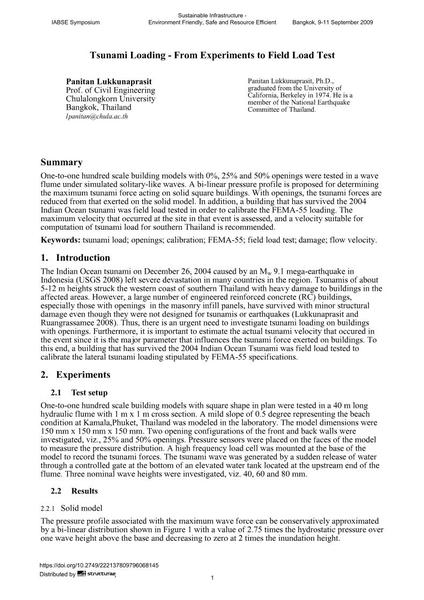Tsunami Loading - From Experiments to Field Load Test

|
|
|||||||||||
Bibliographic Details
| Author(s): |
Panitan Lukkunaprasit
|
||||
|---|---|---|---|---|---|
| Medium: | conference paper | ||||
| Language(s): | English | ||||
| Conference: | IABSE Symposium: Sustainable Infrastructure - Environment Friendly, Safe and Resource Efficient, Bangkok, Thailand, 9-11 September 2009 | ||||
| Published in: | IABSE Symposium Bangkok 2009 | ||||
|
|||||
| Page(s): | 1-8 | ||||
| Total no. of pages: | 8 | ||||
| Year: | 2009 | ||||
| DOI: | 10.2749/222137809796068145 | ||||
| Abstract: |
Two important issues arise from the field observations of the buildings that have survived the 2004 Indian Ocean tsunami. First, how effective are openings in reducing the tsunami loading on buildings. Second, the actual velocity that occured in the event might have not been as large as implied in existing guidelines on tsunami loading. This paper presents studies aimed to address these two issues by means of experiments and a field load test. One-to-one hundred scale building models with 0%, 25% and 50% openings were tested in a wave flume under simulated solitary-like waves. A bi-linear pressure profile is proposed for determining the maximum tsunami force acting on solid square buildings. Depending on the sizes of openings, the tsunami forces are reduced by 15% - 30% from that exerted on the solid model. In addition, a building that has survived the 2004 Indian Ocean tsunami was field load tested in order to calibrate the FEMA-55 loading. The maximum velocity that occurred at the site in that event is assessed, and a velocity suitable for computation of tsunami load for southern Thailand is recommended. |
||||
| Keywords: |
damage openings experiments calibration flow velocity tsunami load FEMA-55 field load test
|
||||
